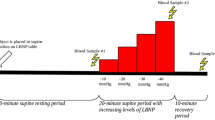Abstract
We investigated seasonal changes in hormonal and thermoregulatory responses. Eight volunteers were subjected to the experiment at four times of the year: around the vernal and autumnal equinoxes, and at the summer and winter solstices at latitude 35° N. Plasma antidiuretic hormone (ADH), angiotensin II (ANG II), aldosterone (ALD) and plasma renin activity (PRA) were analyzed before and after water immersion. Seasonal changes in thermoregulatory responses were assessed by measuring core temperature and sweat rate during immersion of the leg in hot water (at 42°C) for 30 min in a room maintained at 26°C. The concentration of plasma ADH and ALD before water immersion was significantly higher in summer than in other seasons. The concentrations of ANG II and PRA did not show seasonal variations. Changes in tympanic temperature during water immersion showed significant differences between seasons, and were higher in winter than in other seasons. The sweat rate was significantly higher in summer than in other seasons. In summary, ADH and ALD concentrations displayed a seasonal rhythm with marked elevation in summer; this may be a compensative mechanism to prevent dehydration from increased sweat loss during summer due to heat acclimatization.



Similar content being viewed by others
References
Finberg JP, Katz M, Gazit H, Berlyne GM (1974) Plasma renin activity after acute heat exposure in nonacclimatized and naturally acclimatized man. J Appl Physiol 36(5):519–523
Follet BK, Follet DE (1981) Biological clocks in seasonal reproductive cycles. Wright, Bristol
Forsling ML, Ingram DL, Stanier MW (1976) Effects of various ambient temperatures and of heating and cooling the hypothalamus and cervical spinal cord on antidiuretic hormone secretion and urinary osmolality in pigs. J Physiol 257(3):673–686
Honma K, Honma S, Kohsaka M, Fukuda N (1992) Seasonal variation in the human circadian rhythm: dissociation between sleep and temperature rhythm. Am J Physiol 262(5 Pt 2):R885–R891
Horowitz M, Epstein Y, Shapiro Y (1992) Vasopressin in thermoregulation–competitive demands: experimental evidence and theoretical considerations. Physiol Res 41(1):41–48
Kuno Y (1956) Human perispiration. Thomas, Springfield
MacFarlane WV, Robinson KW (1957) Seasonal changes in plasma antidiuretic activity produced by a standard heat stimulus. J Physiol 135(1):1–11
MacGeehin MA, Mirabelli M (2001) The potential impacts of climate variability and change on temperature-related morbility and mortality in the United States. Environ Health Perspect 109(Suppl 2):185–189
Matsumoto T, Kosaka M, Yamauchi M, Tsuchiya K, Ohwatari N, Motomura M, Otomasu K, Yang GJ, Lee JM, Boonayathap U, Praputpittaya C, Yongsiri A (1993) Study on mechanism of heat acclimatization due to thermal sweating. Trop Med 35(1):23–34
Nielsen B, Hales JR, Strange S, Christensen NJ, Warberg J, Saltin B (1993) Human circulatory and thermoregulatory adaptations with heat thermoregulatory adaptations with heat acclimation and exercise in a hot, dry environment. J Physiol 460:467–485
Ogawa T (1997) Where should core temperature be measured in human experiments? J Hum Environ Syst 1(1):47–55
Ohara K (1966) Chloride concentration in sweat; its individual, regional, seasonal and some other variations, and interrelations between them. Jpn J Physiol 16(3):274–290
O’Neill MS, Ebi KL (2009) Temperature extremes and health: impacts of climate variability and change in the United States. J Occup Environ Med 51:13–25
Otomasu K, Yamauchi M, Ohwatari N, Matsumoto T, Tsuchiya K, Kosaka M (1997) Analysis of sweat evaporation from clothing materials by the ventilated sweat capsule method. Eur J Appl Physiol Occup Physiol 76(1):1–7
Pittman QJ, Poulin P, Wilkinson MF (1993) Role of neurohypophysial hormones in temperature regulation. Ann N Y Acad Sci 689:375–381
Rowell LB, Brengelmann GL, Blackmon JR, Murray JA (1970) Redistribution of blood flow during sustained high skin temperature in resting man. J Appl Physiol 28(4):415–420
Schneider EG, Davis JO, Baumber JS, Johnson JA (1970) Renin, aldosterone, and hypertension. The hepatic metabolism of renin and aldosterone. A review with new observations on the hepatic clearance of renin. Circ Res (Suppl 1):175–183
Segar WE, Moore WW (1968) The regulation of antidiuretic hormone release in man: I. Effects of change in position and ambient temperature on blood ADH levels. J Clin Invest 47(9):2143–2151
Shapiro Y, Hubbard RW, Kimbrough CM, Pandolf KB (1981) Physiological and hematologic responses to summer and winter dry-heat acclimation. J Appl Physiol 50(4):792–798
Sugenoya J, Ogawa T (1985) Characteristics of central sudomotor mechanism estimated by frequency of sweat expulsions. Jpn J Physiol 35(5):783–794
Tagawa H, Vander AJ, Bonjour JP, Malvin RL (1971) Inhibition of renin secretion by vasopressin in unanesthetized sodium-deprived dogs. Am J Physiol 220(4):949–951
Takagi T (1986) Longitudinal study on circadian rhythms of plasma hormone levels during Japanese Antarctic research expedition. Hokkaido Igaku Zasshi 61(1):121–133
Touitou Y, Portaluppi F, Smolensky MH, Rensing L (2004) Ethical principles and standards for the conduct of human and animal biological rhythm research. Chronobiol Int 21(1):161–170
Touitou Y, Smolensky MH, Portaluppi F (2006) Ethics, standards, and procedures of animal and human chronobiology research. Chronobiol Int 23(6):1083–1096
Wilkins DC (1971) Heat acclimatization in the Antarctic. J Physiol 214(1):15P–16P
Acknowledgments
This study was supported by a grant-in-aid for JSPS Fellow (18.06719) from the Japan Society for the Promotion of Science.
Author information
Authors and Affiliations
Corresponding author
Rights and permissions
About this article
Cite this article
Kanikowska, D., Sugenoya, J., Sato, M. et al. Influence of season on plasma antidiuretic hormone, angiotensin II, aldosterone and plasma renin activity in young volunteers. Int J Biometeorol 54, 243–248 (2010). https://doi.org/10.1007/s00484-009-0275-7
Received:
Revised:
Accepted:
Published:
Issue Date:
DOI: https://doi.org/10.1007/s00484-009-0275-7




